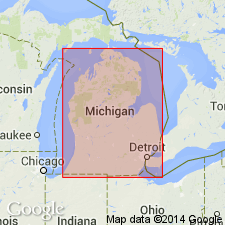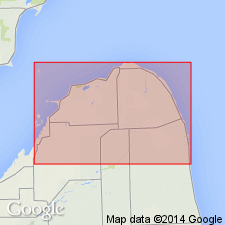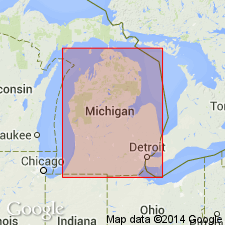
- Usage in publication:
-
- Bayport limestone*
- Modifications:
-
- [Incidental mention]
- Dominant lithology:
-
- Limestone
- AAPG geologic province:
-
- Michigan basin
Summary:
Pg. 81. Mentioned Bayport limestone as having "strongest possible resemblance to Grand Rapids limestone in character and in fossils, and both are intimately associated with and underlain by sandstones." [Age is Mississippian.]
[Named from outcrops at Bayport, Huron Co., Lower Peninsula, MI, where it is quarried.]
Source: US geologic names lexicon (USGS Bull. 896, p. 129).

- Usage in publication:
-
- Maxville or Bayport limestone
- Modifications:
-
- Principal reference
- AAPG geologic province:
-
- Michigan basin
Summary:
btw. p. 1 and 30. Maxville or Bayport limestone. Sandy yellow limestones, cross-bedded white sandstone, a little dolomite. Thickness 20 to 50+ feet. Top formation of Grand Rapids group or series. Overlies Michigan series [formation]. At bottom of Coal Measures is a sandstone separated off by Winchell under name of Parma sandstone. I believe Bayport limestone in its sandy phase is Parma sandstone. [Later reports by Lane and others treat Parma sandstone as younger than Bayport limestone, and of Pottsville age. Maxville limestone is an Ohio formation. ca. 1936, age of Bayport is Mississippian.]
[Named from outcrops at Bayport, Huron Co., Lower Peninsula, MI, where it is quarried.]
Source: US geologic names lexicon (USGS Bull. 896, p. 129).

- Usage in publication:
-
- Bayport Limestone
- Modifications:
-
- Areal extent
- AAPG geologic province:
-
- Michigan basin
Summary:
The Bayport is exposed in the eastern part of the Michigan basin in Arenac Co. as well as at the type locality of Bay Port. Exposures in the southern part of the basin are near Parma, Jackson Co., and at Bellevue, Eaton Co. It is also exposed at Grand Rapids, Kent Co., on the southwestern side of the basin. This is the youngest of the Mississippian formations in the area and contains marine invertebrate fossils taxonomically similar to those found in the St. Louis and Ste. Genevieve Limestones of the Mississippi Valley region which are Meramecian in age. Unit is restricted geographically to a more central portion of the Michigan basin than earlier units. It conformably overlies the Michigan Formation and disconformably underlies the Pennsylvanian Saginaw Formation. Maximum thickness of the Bayport is about 37 m but in most places is 15 to 30 m thick. Unit is lithologically variable, but is predominantly carbonate. It also contains significant amounts of sandstone and minor quantities of shale, bedded chert, and evaporites. No mention of Grand Rapids Group in this report.
Source: GNU records (USGS DDS-6; Reston GNULEX).
For more information, please contact Nancy Stamm, Geologic Names Committee Secretary.
Asterisk (*) indicates published by U.S. Geological Survey authors.
"No current usage" (†) implies that a name has been abandoned or has fallen into disuse. Former usage and, if known, replacement name given in parentheses ( ).
Slash (/) indicates name conflicts with nomenclatural guidelines (CSN, 1933; ACSN, 1961, 1970; NACSN, 1983, 2005, 2021). May be explained within brackets ([ ]).

